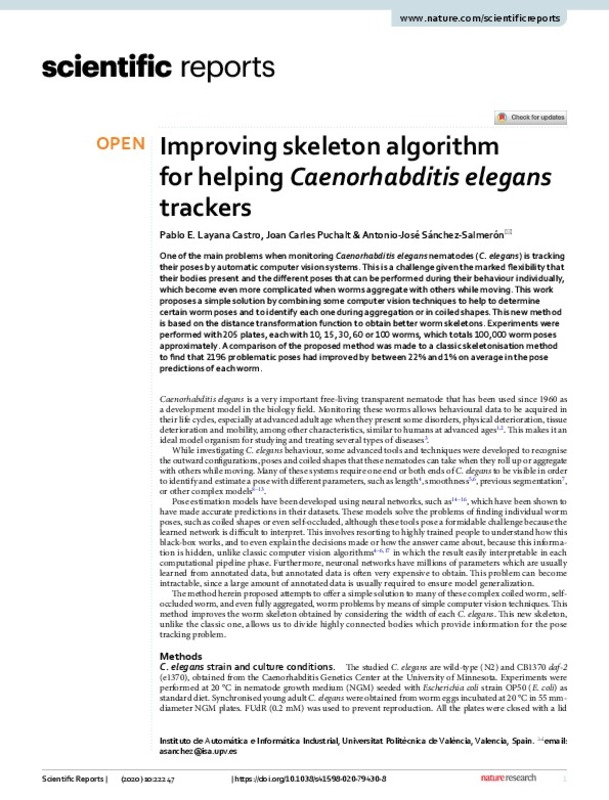Teo, E. et al. A high throughput drug screening paradigm using transgenic Caenorhabditis elegans model of Alzheimer’s disease. Transl. Med. Aging 4, 11–21. https://doi.org/10.1016/j.tma.2019.12.002 (2020).
Kim, M., Knoefler, D., Quarles, E., Jakob, U. & Bazopoulou, D. Automated phenotyping and lifespan assessment of a C. elegans model of Parkinson’s disease. Transl. Med. Aging 4, 38–44. https://doi.org/10.1016/j.tma.2020.04.001 (2020).
Olsen, A. & Gill, M. S. (eds) Ageing: Lessons from C. elegans (Springer, Berlin, 2017).
[+]
Teo, E. et al. A high throughput drug screening paradigm using transgenic Caenorhabditis elegans model of Alzheimer’s disease. Transl. Med. Aging 4, 11–21. https://doi.org/10.1016/j.tma.2019.12.002 (2020).
Kim, M., Knoefler, D., Quarles, E., Jakob, U. & Bazopoulou, D. Automated phenotyping and lifespan assessment of a C. elegans model of Parkinson’s disease. Transl. Med. Aging 4, 38–44. https://doi.org/10.1016/j.tma.2020.04.001 (2020).
Olsen, A. & Gill, M. S. (eds) Ageing: Lessons from C. elegans (Springer, Berlin, 2017).
Wählby, C. et al. An image analysis toolbox for high-throughput C. elegans assays. Nat. Methods 9, 714–6. https://doi.org/10.1038/nmeth.1984 (2012).
Rizvandi, N. B., Pižurica, A., Rooms, F. & Philips, W. Skeleton analysis of population images for detection of isolated and overlapped nematode C. elegans. In 2008 16th European Signal Processing Conference, 1–5 (2008).
Rizvandi, N. B., Pizurica, A. & Philips, W. Machine vision detection of isolated and overlapped nematode worms using skeleton analysis. In 2008 15th IEEE International Conference on Image Processing, 2972–2975. https://doi.org/10.1109/ICIP.2008.4712419 (2008).
Uhlmann, V. & Unser, M. Tip-seeking active contours for bioimage segmentation. In 2015 IEEE 12th International Symposium on Biomedical Imaging (ISBI), 544–547 (2015).
Nagy, S., Goessling, M., Amit, Y. & Biron, D. A generative statistical algorithm for automatic detection of complex postures. PLOS Comput. Biol. 11, 1–23. https://doi.org/10.1371/journal.pcbi.1004517 (2015).
Huang, K.-M., Cosman, P. & Schafer, W. R. Machine vision based detection of omega bends and reversals in C. elegans. J. Neurosci. Methods 158, 323–336. https://doi.org/10.1016/j.jneumeth.2006.06.007 (2006).
Kiel, M. et al. A multi-purpose worm tracker based on FIM. https://doi.org/10.1101/352948 (2018).
Winter, P. B. et al. A network approach to discerning the identities of C. elegans in a free moving population. Sci. Rep. 6, 34859. https://doi.org/10.1038/srep34859 (2016).
Fontaine, E., Burdick, J. & Barr, A. Automated tracking of multiple C. Elegans. In 2006 International Conference of the IEEE Engineering in Medicine and Biology Society, 3716–3719. https://doi.org/10.1109/IEMBS.2006.260657 (2006).
Roussel, N., Morton, C. A., Finger, F. P. & Roysam, B. A computational model for C. elegans locomotory behavior: application to multiworm tracking. IEEE Trans. Biomed. Eng. 54, 1786–1797. https://doi.org/10.1109/TBME.2007.894981 (2007).
Hebert, L., Ahamed, T., Costa, A. C., O’Shaugnessy, L. & Stephens, G. J. Wormpose: image synthesis and convolutional networks for pose estimation in C. elegans. bioRxiv. https://doi.org/10.1101/2020.07.09.193755 (2020).
Chen, L. et al. A CNN framework based on line annotations for detecting nematodes in microscopic images. In 2020 IEEE 17th International Symposium on Biomedical Imaging (ISBI), 508–512. https://doi.org/10.1109/ISBI45749.2020.9098465 (2020).
Li, S. et al. Deformation-aware unpaired image translation for pose estimation on laboratory animals. In 2020 IEEE/CVF Conference on Computer Vision and Pattern Recognition (CVPR), 13155–13165. https://doi.org/10.1109/CVPR42600.2020.01317 (2020).
Puchalt, J. C., Sánchez-Salmerón, A.-J., Martorell Guerola, P. & Genovés Martínez, S. Active backlight for automating visual monitoring: an analysis of a lighting control technique for Caenorhabditis elegans cultured on standard petri plates. PLOS ONE 14, 1–18. https://doi.org/10.1371/journal.pone.0215548 (2019).
Stiernagle, T. Maintenance of C. elegans. https://doi.org/10.1895/wormbook.1.101.1 (2006).
Russ, J. C. & Neal, F. B. The Image Processing Handbook 7th edn, 479–480 (CRC Press, Boca Raton, 2015).
Swierczek, N. A., Giles, A. C., Rankin, C. H. & Kerr, R. A. High-throughput behavioral analysis in C. elegans. Nat. Methods 8, 592–598. https://doi.org/10.1038/nmeth.1625 (2011).
Restif, C. et al. CELEST: computer vision software for quantitative analysis of C. elegans swim behavior reveals novel features of locomotion. PLOS Comput. Biol. 10, 1–12. https://doi.org/10.1371/journal.pcbi.1003702 (2014).
Javer, A. et al. An open-source platform for analyzing and sharing worm-behavior data. Nat. Methods 15, 645–646. https://doi.org/10.1038/s41592-018-0112-1 (2018).
Dusenbery, D. B. Using a microcomputer and video camera to simultaneously track 25 animals. Comput. Biol. Med. 15, 169–175. https://doi.org/10.1016/0010-4825(85)90058-7 (1985).
Ramot, D., Johnson, B. E., Berry, T. L. Jr., Carnell, L. & Goodman, M. B. The parallel worm tracker: a platform for measuring average speed and drug-induced paralysis in nematodes. PLOS ONE 3, 1–7. https://doi.org/10.1371/journal.pone.0002208 (2008).
Puchalt, J. C. et al. Improving lifespan automation for Caenorhabditis elegans by using image processing and a post-processing adaptive data filter. Sci. Rep. 10, 8729. https://doi.org/10.1038/s41598-020-65619-4 (2020).
Rezatofighi, H. et al. Generalized intersection over union: a metric and a loss for bounding box regression. In 2019 IEEE/CVF Conference on Computer Vision and Pattern Recognition (CVPR), 658–666. https://doi.org/10.1109/CVPR.2019.00075 (2019).
Koul, A., Ganju, S. & Kasam, M. Practical Deep Learning for Cloud, Mobile, and Edge: Real-World AI & Computer-Vision Projects Using Python, Keras & TensorFlow, 679–680 (O’Reilly Media, 2019).
[-]









